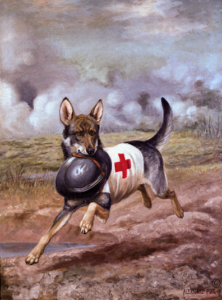 I think many people realize the usefulness of a dog as something other than a pet. Over the years, there have been seeing eye dogs, service dogs, and one I hadn’t heard of before…mercy dogs. During World War I, some 50,000 dogs were “employed” by both sides of the conflict as soldiers on both sides of the conflict as mercy dogs. You might wonder just what a mercy dogs is. While it is a rather sad one, the job the dogs had was actually had a very important job in the military. During battle, these dogs were sent out to find and help wounded men on the battlefield. They were very good at their jobs.
I think many people realize the usefulness of a dog as something other than a pet. Over the years, there have been seeing eye dogs, service dogs, and one I hadn’t heard of before…mercy dogs. During World War I, some 50,000 dogs were “employed” by both sides of the conflict as soldiers on both sides of the conflict as mercy dogs. You might wonder just what a mercy dogs is. While it is a rather sad one, the job the dogs had was actually had a very important job in the military. During battle, these dogs were sent out to find and help wounded men on the battlefield. They were very good at their jobs.
On their backs, the dogs carried medical supplies. They sought out injured soldiers. If a soldier was gravely wounded, the dogs would tear off a piece of his uniform, carry it back to camp, and help other soldiers to locate the man. Sometimes, the dogs found men who were beyond saving. In that case, they lay down next to him, so that the dying soldier didn’t have to die alone. These were true acts of mercy, and these dongs had true compassion for these men.
Mercy dogs were also known as ambulance dogs, Red Cross dogs, or casualty dogs. These dogs actually served in a paramedical role in the military…most notably during World War I, but also in World War II, and the Korean War. They have been credited with saving thousands of lives. The dogs were well trained and well suited for  trench warfare. They were often sent out after large battles, where they would seek out wounded soldiers. They were also trained to guide combat medics to soldiers who required extensive care.
trench warfare. They were often sent out after large battles, where they would seek out wounded soldiers. They were also trained to guide combat medics to soldiers who required extensive care.
The first mercy dogs were actually trained by the German army in the late 19th century. The program to train mercy dogs in 1895 begun by Jean Bungartz in Germany was described as a “novel experiment” by those who knew about it. I’m sure they didn’t think it would actually work. Nevertheless, by 1908, Italy, Austria, and France had joined Germany in training programs for mercy dogs. Germany had around 6,000 trained dogs by the beginning of World War I. Many of the trained dogs were ambulance dogs. The German army called them Sanitätshunde or medical dogs. Germany is estimated to have used a total of 30,000 dogs during the war, mainly as messengers and ambulance dogs. Amazingly, only 7,000 of those were killed. Somehow, I would have expected there to be more deaths among the dogs. It is estimated that upwards of 50,000 dogs were successfully used by all of the nations involved in the war.
When World War I started, Britain did not have a program for training military dogs. Edwin Hautenville Richardson, who was an officer in the British Army had experience working with military dogs and had advocated for the start of a military program since 1910, but his program was not taken seriously. Nevertheless, he had trained several dogs as ambulance dogs on his own. He quickly offered them to the British Army. The army did not accept his offer, for some bizarre reason, so he gave them to the British Red Cross. As a result of his advocacy, Britain created a British War Dog School with Richardson as the commander. The school eventually trained more than 200 dogs. The British War Dog School was a grand success.

It is estimated that as many as 10,000 dogs served as mercy dogs in World War I, and are credited with saving thousands of lives, including at least 2,000 in France and 4,000 wounded German soldiers. There were several dogs that were specifically honored for their work. “Captain” was credited for finding 30 soldiers in one day, and “Prusco” for finding 100 men in just one battle. Both of these were French dogs. “Prusco” was known to drag soldiers into ditches as a safe harbor while he went to summon rescuers. Sadly, many French dogs were killed in the line of duty, and the program was discontinued. I suppose they thought it was inhumane, but I’m sure the dogs knew they were doing important work.


One Response to Doing Important Work